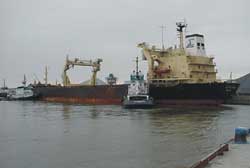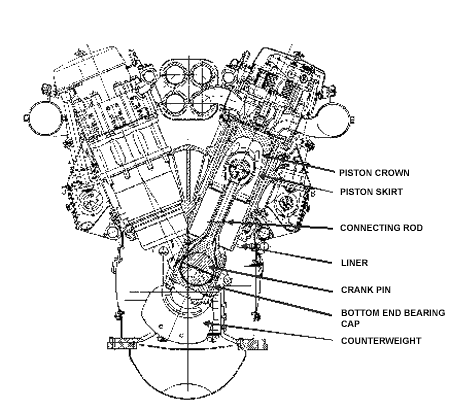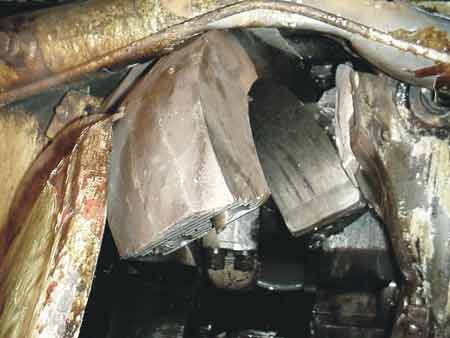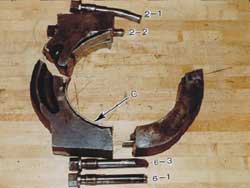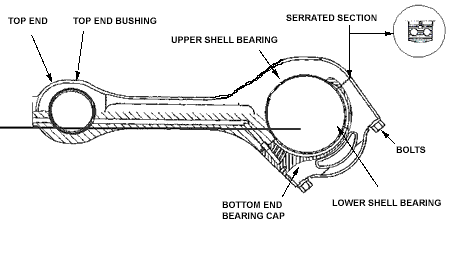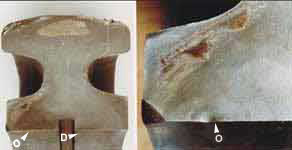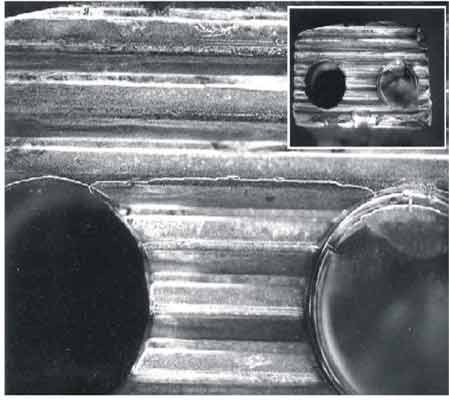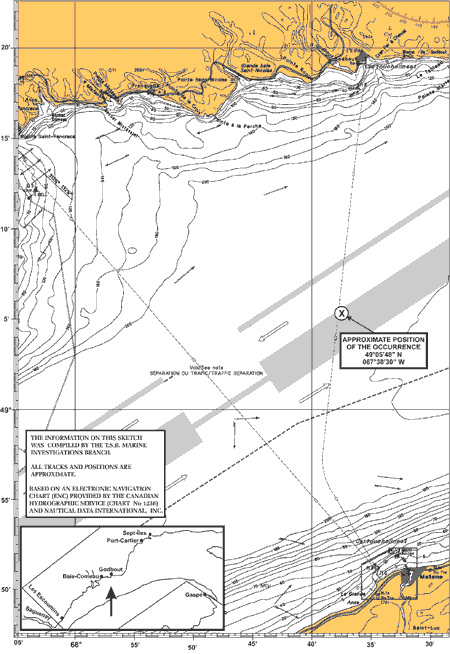Main Engine Failure
General Cargo Carrier Millenium Yama
St. Lawrence River
The Transportation Safety Board of Canada (TSB) investigated this occurrence for the purpose of advancing transportation safety. It is not the function of the Board to assign fault or determine civil or criminal liability. This report is not created for use in the context of legal, disciplinary or other proceedings. See Ownership and use of content. Masculine pronouns and position titles may be used to signify all genders to comply with the Canadian Transportation Accident Investigation and Safety Board Act (S.C. 1989, c. 3).
Summary
On 11 April 2000, the Millenium Yama was inbound on the St. Lawrence River. Off Godbout, Quebec, the vessel sustained a major main engine failure. Sudden stoppage of the engine caused a small fire, which was quickly put out, but the main engine could not be restarted. That evening, the vessel was towed to Baie-Comeau, Quebec, by the tug Pointe Comeau. Two days later, the vessel was towed to the port of Québec for repair.
Factual information
| Name | « MILLENIUM YAMA » |
|---|---|
| Official Number | 720494 |
| Port of Registry | Nassau, Bahamas |
| Flag | Bahamas |
| Type | General cargo carrier |
| Gross TonnageNote de bas de page 1 | 14038 |
| Length | 164.34 m |
| Draught | Forward:7.90 m Aft:7.95 m |
| Cargo | Pumice |
| Crew Members | 18 |
| Built | 1979, Ishikawajima-Harima Heavy Industries (IHI) Co. Ltd., Japan |
| Propulsion | One Pielstick 12PC2-5V-400 diesel engine, 5,737 kW, driving one variable-pitch propeller |
| Owners | Millenium Maritime Services Ltd., Greece |
Description of the vessel
Millenium YamaDescription of the Main Engine
The main engine is a Pielstick medium-speed marine engine. It drives a variable-pitch propeller and a shaft coupling generator through a reduction gearbox. The engine was designed by the Société d'étude de machines thermiques (SEMT) and manufactured under licence in 1977 by IHI Co. Ltd. in Japan. It is a single-acting, four-stroke, supercharged, trunk-piston, non-reversing, Vee-type engine. The engine develops maximum power at 520 rpm.
The engine has a welded main casing constructed of steel plate, forged steel, and cast steel. Welded joints are concentrated in areas of lowest stress. Weld lines subjected to high stress are carefully designed and easily accessible for inspection. The suspended crankshaft is forged in one piece. Counterweights are mounted in notches on the webs and secured at the centre by a pin.
History of the voyage
On 25 March 2000, the Millenium Yama departed the port of Yali, Greece, with a cargo of 15,500 tonnes of pumice, bound for Cleveland, USA. The vessel encountered relatively rough seas and high winds on the Atlantic Ocean, but the crossing was without incident. On the morning of April 11, the vessel was proceeding up the St. Lawrence, off Godbout.
Before the watch changed, around 1200,Note de bas de page 2 off Pointe-des-Monts, the master reported to Marine Communications and Traffic Services (MCTS) in Les Escoumins that the vessel had passed calling-in point 2A. Meanwhile, the third engineer joined the fourth engineer in the engine room.
At 1204, a thumping noise was heard by persons in the accommodation. The main engine suddenly stopped, and a total blackout followed shortly afterward. A fire in way of the No 9 unit of the main engine was extinguished immediately by a response team.
After surveying the damage, the chief engineer advised the master that the main engine was out of commission. The master then advised MCTS in Les Escoumins and other vessels in the area that the vessel was adrift and "not-under-command". The master then informed his company of the status and position of the vessel in order to obtain towing services.
The tug Pointe Comeau was dispatched to the site, and around 2145 it started to tow the Millenium Yama to an anchorage off Baie-Comeau. On April 13 the tug Ocean Hercules towed the vessel to the port of Québec, where it was berthed at section 107 on April 14, at 1655.
Injuries to persons
There were no injuries.
Damage to the vessel
Inspection of the main engine revealed that the connecting rod (con-rod) had separated from piston No 3.Note de bas de page 3 The piston crown had separated from the skirt, which was in pieces. The crankshaft was bent at the No 4 main bearing. The exhaust valve and push rods for the exhaust and inlet valves in the No 3 cylinder head were also bent. The No 6 counterweight and the piston end of the No 3 con-rod were jammed between the crank pin and the bottom of the liner and the casing (Figure 1).
The bottom end of the No 3 con-rod punched through the right side of the main engine, damaging the casing and inspection door at unit No 9. The lube oil and coolant lines and the flexible coupling were also damaged (Photo 2).
Debris from the liner, piston, bearing shell, con-rod, counterweight, con-rod cap, pin, bearing shell, and other parts were strewn about in the crank case in way of the failed unit.
To determine how and why the bottom end of the con-rod separated from the crankshaft, the two pieces of the con-rod cap, part of the upper portion of the con-rod, the four con-rod cap bolts, and the pieces of the lower bearing shell and piston skirt were sent to the TSB Engineering Laboratory for analysis.
Certification
Vessel Certification
The vessel's inspection certificates were valid. The most recent Port State Control (PSC) inspection was in Vlissingen, Netherlands, where two deficiencies, not related to engine room machinery, were noted. The vessel was built in 1979 according to requirements of the classification society, American Bureau of Shipping (ABS), and had been surveyed by this society since her construction.
The owner had until 1 July 2002 to bring the vessel into compliance with the International Safety Management (ISM) Code.Note de bas de page 4 In early April 2000, a short time before the occurrence, the vessel had received, from the company, a report concerning the process of implementation for ISM.
Personnel Certification
The chief engineer and watch officers on the Millenium Yama held the required certificates, issued by the USSR, for the power of main engine they were operating. The officers' certificates of competency were in compliance with the International Convention on Standards of Training, Certification and Watchkeeping for Seafarers (STCW).
Personnel history
Chief Engineer
The chief engineer held a First Class Engineer certificate (Motor), issued by the Ministry of Merchant Marine of the USSR. He started as an apprentice in 1971, and had been working as a chief engineer since 1984. He first joined this vessel on 16 September 1999. During his career, he gained considerable experience on this type of engine.
Watch Engineer
The watch engineer (8 to 12) held a Third Class Engineer certificate (Motor), issued by the Ministry of Merchant Marine of the USSR. He began his career at sea in 1981. In 1983, he completed his training as an automated systems specialist. In 1998, he was appointed to his first position as watch engineer. He first joined this vessel on 6 January 2000.
Weather and Tidal Forecasts
On 11 April 2000, the weather in the Baie Comeau area was partly hazy with a light wind and slight sea. Around 1204 on 11 April 2000, approximately four hours after forecast high tide, the vessel was in an ebb current (downbound current). The combined effect of the wind and tide produced a drift of about 1.2 knots, in a direction of approximately 110° True.
History of the Vessel and Main Engine
Vessel Name, Ownership, and Flag
| Date | Owner | Name | Flag | Registry |
|---|---|---|---|---|
| 1979 launched |
Seaspeed Navigation Company Ltd. | Therean Mariner | Greece | Piraeus |
| 1984 | Radiant Navigation Corporation | Navigator | Liberia | Monrovia |
| 1989 | Hansa Riga A/S, Norway | Hansa Riga | Norway | Oslo |
| 1991 | Yama Shipping Co. Ltd., Greece | Yama | Bahamas | Nassau |
| 1994 | Yama Shipping Co. Ltd., Greece | Renamed Clipper Yama | Bahamas | Nassau |
| 1998 | Millenium Maritime Services Ltd., Greece | Millenium Yama | Bahamas | Nassau |
Main Engine
The main engine has been overhauled several times, either for preventive maintenance or as part of the five-year inspection requirements of the classification society.
Since the vessel was launched in 1979, the main engine was damaged on several occasions.Note de bas de page 5 In September 1989, two cracks were discovered in the main engine casing. One crack was in way of the vibration damper, the other on the starboard side near the No 12 unit inspection door.
In September 1990, on a voyage from Taiwan to the United States, the main engine had a crankcase explosion. The No 3 gudgeon pin was seized in the con-rod top end bushing. Number 3 crankshaft journal was also damaged. The No 3 con-rod bottom end bearing shell was torn. Two more cracks were found in the casing.
In November 1992, on a voyage from Taiwan to Australia, another engine crankcase explosion occurred. The No 1 piston seized in its liner. The crankshaft journal in way of the No 1 was out-of-round by 0.85 mm.
In March 1993, on a voyage from Australia to Egypt, the main engine was damaged again. The crankshaft failed in way of the No 5 bearing. Main bearing shells Nos 1 to 7 and Nos 1 to 12 con-rod bottom end bearing shells were damaged, as was the vibration damper. Another crack was discovered in the casing.
In March 1997, on a voyage from Germany to the United States, the crankshaft journal, connecting rods and bottom end bearing shells on the no 1 and 7 units of the main engine were damaged due to low oil pressure.
In August 1999, the main engine failed again at sea. Repairs took several hours and involved the replacement of many parts. However, the classification society was not made aware of these repairs.
As of the failure in April 2000, the subject occurrence, the main engine had accumulated about 108,000 running hours.
Replacement Parts
A large inventory of replacement parts, new and used, was on board. New items in inventory included bearing shells, O-rings and other small parts. Most large parts, such as cylinder heads, pistons, con-rods, and cylinder liners, were used. These used parts had been tagged "Used but still good". Most of these parts had been reconditioned by engine room personnel. The parts were visually inspected, measured and, where possible, pressure tested according to the manufacturer's procedures and standards. Test results were recorded in a maintenance report.
Parts that could not be repaired on board, because they required more extensive work, were sent to a repair shop. These parts were inspected by the chief engineer when they were returned to the ship. The parts repaired in a repair shop did not always have a certificate stating that they were approved and met standards.
The parts inventory, which included used parts, was kept by the chief engineer. It was updated periodically. No record was kept of the quality of replacement parts. Requisitions were prepared by the chief engineer and approved by the master. When in port, used replacement parts were sometimes unexpectedly received from the company without any documentation.
Connecting Rods
Unit Numbering
When facing forward towards the engine flywheel, cylinder units Nos 1 to 6 are on the port side and cylinder units Nos 7 to 12 are to starboard. Con-rods are numbered and stamped with a number from 1 to 12, indicating to which cylinder unit they belong.
Numbering at Time of Occurrence
Eight out of 12 con-rods were marked with approval number A404B and dated 6 May 1977; the other four had different markings. Con-rods No 2, 6, and 12 were installed in their respective cylinder units.
Three replacement con-rods were in storage; only one bore the approval number A404B and was manufactured on 6 May 1977. However, it could not be determined whether the series of con-rods marked with approval number A404B and dated 6 May 1977 was original to the engine when it was manufactured in 1977, or whether it was from another source.
Position of Damaged Connecting Rod
On 20 August 1999, a replacement con-rod was installed in unit No 3, along with new bearing shells. The con-rod was marked No 11 and bore approval number A404B. Prior to that, it had been kept in the stores as a replacement.
Con-Rod Maintenance Prescribed by Manufacturer
The manufacturer recommends that con-rods be inspected as follows, after 24,000 running hours:Note de bas de page 6
- Measure the inner diameter of the bush.
- Conduct a Dye Penetration Test of the con-rod cap serrated faces of the oblique bottom end joint. Any crack shall be submitted to an examination by the manufacturer, who will decide whether the con-rod cap is to be rejected.
- Perform a Magnetic Particle Crack-Detection Test on the con-rod bottom end screws or bolts. Failing that, carry out a Dye Penetration Test.
- Perform a dimensional inspection of the connecting rod bottom end bore.
Analysis
Cause of Main Engine Failure
The main engine failure started with the No 3 con-rod bottom end detaching from the crankshaft. This triggered a chain of parts separation. With no cap to hold it in place, the con-rod unseated from the crank pin and struck the counterweight. The impact sheared the pin securing the counterweight in its notches. As the crankshaft continued to rotate, it struck the counterweight and con-rod, jamming them against the lower edge of the No 3 cylinder liner. The force transmitted by the con-rod top end to its gudgeon pin caused the piston skirt to break into several pieces. The impact of the con-rod bottom end striking the starboard casing wall punctured the casing, damaging the oil and fresh water lines.
In most cases of con-rod detachment, the bottom end cap separates from the upper part of the con-rod, which is caused by a failure of either the securing bolt or the cap. The bolts usually fail in fatigue caused by unequal torquing.
The Board determined that the con-rod cap became detached from the con-rod due to a fracture and not due to failure of the bolts. It was noted that the crack developed in the thinnest section of the con-rod cap.Note de bas de page 7 It originated in a corrosion pit on the contact surface with the bearing shell, then propagated to over 95 percent of the cap surface through high cycle fatigue. The cap subsequently failed in overload in the smallest section. The break-up of the cap caused the four bolts to fracture.
In this occurrence, the con-rod cap fractured near its centre. This seldom occurs, since the central portion is generally subjected to very little stress. Stresses are normally concentrated in the upper portion of the con-rod.
Equipment Maintenance
Role of Manufacturer
Each manufacturer builds its engines to specific manufacturing standards, which vary considerably throughout the range of products available on the market. All new marine engines come with a warranty against manufacturing defects. To maintain original performance, the use of original parts is highly recommended, coupled with operating instructions and maintenance schedules provided by the manufacturer.
For instance, SEMT Pielstick prescribes that connecting rods be inspected regularlyNote de bas de page 8 and recommends that a dye penetration test be conducted on the serrated area after 24,000 running hours, because of its susceptibility to cracks. Subsequent to this occurrence, TSB analysis on the connecting rod cap revealed that cracks were present in this serrated area, illustrating the importance of following manufacturer's recommended maintenance practices.
Owner Responsibility
Owners generally maintain a vessel in a seaworthy condition by complying with IMO conventions adopted by the flag state and implemented by regulation and with rules and standards of the ship's classification society.
Most ship's engines are maintained in accordance with maintenance programs recommended by the manufacturer. Engine performance and service life depend mainly on maintenance and the owner's commitment to follow manufacturer recommendations. Any major repairs carried out at sea should be reported to the classification society. This was not done in August 1999.
The manufacturer of the main engine of the Millenium Yama recommended a stringent inspection after a specific period of operation. On an ocean-going vessel of this type, the main engine may run 6,000 to 8,000 hours a year, depending on the type and number of voyages made. It is estimated that all of this main engine's parts were inspected at least four times. The ship's maintenance log indicates that all 12 units of the main engine were overhauled since it was purchased in 1998.
Role of Classification Society
Classification societies dictate how ships are built and maintained. Surveys are undertaken at regular intervals to ensure that the condition of a ship and it's machinery satisfies the requirements of classification rules. The Millenium Yama was monitored by ABS, a member society of the International Association of Classification Societies (IACS). The society has observer status at IMO, and its principal objectives are to ensure maximum safety at sea and to prevent marine pollution.
Engine room components essential to vessel operation are monitored. Critical parts of the main engine must be meticulously inspected. However, only the parts that are actually in the engine are inspected. All new parts are approved by the classification society, but parts that are used but considered to be still good are not inspected, unless they undergo repairs or a major modification. Generally, societies have no system for identifying condemned parts. As such, if a condemned part is not destroyed or identified, it can be reinstalled on board or on another engine.
Quality Control of Parts
The main engine had sustained major damage several times since the ship was launched in 1979. The damage forced the owners to replace several major parts, including the crankshaft, cylinder head, con-rods, pistons (crown and skirt), gudgeon pins, main bearing shells, and liners.
Parts, like pistons, cylinder heads, con-rods, injectors, starting air valves, relief valves, and inlet/exhaust valves, are often replaced with used parts that meet manufacturer specifications. On some vessels, large parts, like pistons, con-rods, cylinder heads, and head components, are pre-assembled to facilitate replacement and reduce repair time. This practice can result in inadequate parts control. After several replacements, parts are interchanged with others in the main engine; parts in a given unit no longer bear the same number as the unit.
It is possible that the con-rod marked "No 11" was present when the crankshaft was previously damaged. It may have been damaged at that time, removed from the engine, and kept on board as a spare. Then, when emergency repairs were done at sea in August 1999, it would have been installed in the No 3 unit.
No documentation was found to indicate that spare parts were certified valid and within specification when the vessel was sold in 1998. Since the last change of ownership, engine room personnel had to rely on their own experience, due to a lack of information, to judge the quality of replacement parts in the main engine.
Ship Documentation
Regulation 2, Chapter IX of the 1974 International Convention for the Safety of Life at Sea (SOLAS), adopted in 1994, states the application date of the ISM Code for general cargo vessels as being not later than 1 July 2002.
The owner had already begun to forward to the vessel reference documentation required to comply with the ISM Code. One chapter covers machinery maintenance, parts inventory, and quality control.
The main engine and generators are major components. The main engine provides propulsion power and, in many cases, contributes to keeping the vessel seaworthy in foul weather. The generators produce electrical power required to operate all on-board equipment. Modern machinery, propulsion machinery in particular, is increasingly sophisticated and sometimes operates close to its performance limits. The condition of machinery parts is critical to maintaining that level of performance and, therefore, they require meticulous maintenance. To maintain optimum performance, each part should receive individual attention. When a component repeatedly exhibits diminished performance or frequently breaks down, the person in charge records these events in a log, which is useful for all engine room personnel and can assist in evaluating the condition of an engine.
Reference documentation is specific to each company and may vary according to the type of vessel. This documentation is indispensable for determining machinery performance and engine room effectiveness.
Since engine room logs belong to the owners of a vessel, very little historical information on the defective connecting rod could be obtained. The only information found was its number (11), the approval number (A404B),Note de bas de page 9 and the date of manufacture (1977).
Record Keeping and Documentation
This occurrence took place in a relatively unrestricted waterway. It could equally have occurred in confined waters, however, where the consequences might have been more serious.
One of the advantages of the ISM Code is that it requires that information be documented. In the shipping industry, a great deal of information concerning the main engine and other components is conveyed verbally. Although this form of communication is very common, it is not adequate in all situations, particularly in situations where there are changes in personnel, There is a strong possibility that information will be altered, misinterpreted, or lost.
Many changes relating to risk management are currently under way in the shipping industry:
- In July 1995, the IACS implemented the Transfer of Class Agreement (TOCA) to eliminate the possibility that required repairs would not be made after a change of classification society and to ensure "through life" compliance.
- As of 1 January 1996, for PSC, an enhanced survey program has been in effect for bulk carriers and oil tankers of at least 500 gross tons.Note de bas de page 10 The program concerns inspections of the ship's structure and inspection program documentation, which must be kept on board throughout the life of the vessel.
Safety is enhanced when the history of a vessel and its equipment is available. The Millenium Yama has changed ownership five times. The lack of information on its replacement parts history is due to relevant information not being passed on from previous owners to subsequent owners. There are no regulations requiring owners to have and maintain on-board records of service and replacement parts.
Findings
Findings as to causes and contributing factors
- The connecting rod cap detached from the connecting rod due to a fracture that developed in the thinnest section near its centre.
- No reference documentation was found on board that would have allowed engine room personnel to determine the condition and origin of the connecting rod.
Findings as to risk
- Classification societies are not required to identify condemned parts.
- Vessels are not required to have or maintain permanent on-board records of replacement parts, and existing rules and regulations do not address the history of, or quality control for, major parts.
Others Findings
- Major repairs were carried out at sea and not reported to the classification society in accordance with classification rules.
Safety action
Safety action taken
On 7 August 2001, a Marine Safety Information letter was sent to the vessel owners, which summarized the cause of the machinery failure. It advised that there were neither maintenance records aboard nor a system in place whereby records are passed from a current owner to a subsequent one. Such a situation resulted in a new owner having insufficient machinery history data available in order to make informed maintenance decisions and ensure continued safety.
In response, the owners of the vessel at the time of the occurrence agreed that the transfer of maintenance records to subsequent vessel owners of the vessel would be advantageous for the purposes of preventative maintenance. It was indicated that the transfer of such records for the Millenium Yama was far from common during the major part of the lifetime of the vessel. However, the owners were fortunate that the vessel had been maintained with the same Classification Society throughout its life and there was, as a result, a contiguous record of all significant maintenance and repair records for the vessel.
Having a vessel classed with the same Classification Society throughout it's life will result in continuity of records, however it is only recently that Classification Societies have begun allowing new owners to access historical survey information through online database systems such as Lloyd's "Class Direct Online" and American Bureau of Shipping's "Safe Ship" program. However throughout most of the Millenium Yama's service life, such online services had not yet been developed and Classification Societies did not readily release information when a vessel changed hands, especially when accompanied by a change in Class.
A copy of the MSI was forwarded to Transport Canada, who responded that they have added the vessel to its "Ships of Particular Interest" list. As a result, the vessel will be boarded when it arrives in Canada for a Port State Control inspection.
This report concludes the Transportation Safety Board's investigation into this occurrence. Consequently, the Board authorized the release of this report on .
Appendices
Appendix A - Sketch of the Occurrence Area
Appendix B - Glossary
- ABS
- American Bureau of Shipping
- con-rod
- connecting rod
- IACS
- International Association of Classification Societies
- IHI
- Ishikawajima-Harima Heavy Industries, Co. Ltd.
- IMO
- International Maritime Organisation
- ISM
- International Safety Management
- MCTS
- Marine Communications and Traffic Services
- PSC
- Port State Control
- rpm
- revolution(s) per minute
- SEMT
- Société d=étude de machines thermiques
- SOLAS
- International Convention for the Safety of Life at Sea
- TOCA
- Transfer of Class Agreement
- TSB
- Transportation Safety Board
